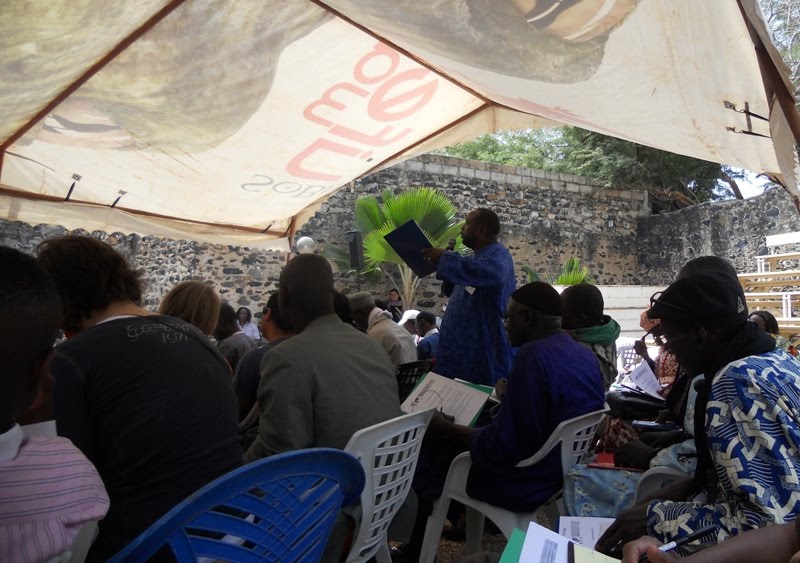Along with NNIRR board member Gerald Lenoir of the Black Alliance for Just Immigration (BAJI) and NNIRR member Nunu Kidane of Pririty Africa Network (PAN), our first stop in Dakar on February 2nd – 4th, was at the World Assembly of Migrants to deliberate the World Charter for Migrants, taking place on the Island of Goree. (Checkout the BAJI and PAN blogs.)
Initiated by a migrant collective in Marseilles, France, the World Charter was intended to create a global charter of principles “guaranteeing the freedom of movement and of establishment for men and women everywhere on our planet.” After presenting this concept to the World Social Forum on Migration in Rivas, Spain in 2006, this initiative continued to percolate and develop, and eventually organizers proposed this World Assembly to deliberate and and launch the World Charter.
The World Assembly of Migrants took place on the island of Goree, which presents a unique and powerful location for any such gathering. Goree is infamous as the gateway through which slaves were traded during the Transatlantic Slave Trade. It houses a somber memorial in the form of the Slave House, built in the 1700s, through which millions of slaves from around West Africa were brutally transported to the Americas. (For a pictorial tour of the Slave House, visit the author’s online album: “Brutal, Forced Migration: Goree Island Revisited.”)
Unfortunately, the so-called World Assembly of Migrants, failed to live up to its name or expectations. Firstly, aside from the 100 or so participants from Francophone West/North Africa and Western Europe, there were only a handful from other regions; 1 person from Latin America, the 3 of us from North America, and not even a single participant from Asia! There was little recognition of the long-existing migrant rights movements in these regions, and all deliberation seemed mostly relevant to only the regions represented there.
Certainly the usual challenges for participation in any international convening of grassroots migrant communities existed — lack of resources, barriers to free movement and travel, inability to access information etc. — but it was also clear that no real effort to engage a more global process was undertaken and it seemed organizers were either blinded to this glaring gap or dismissive of it. This also meant our participation was sidelined to that of passive observers — listening in on translation devices, not being able to truly engage, and not having our minimal comments translated for other participants.
Furthermore, it seemed that various critical issues (race, globalization, sexuality, gender, indigenous peoples’ rights, among others) were purposefully excluded from the Charter, with seemingly misplaced intentions. Organizers aggressively defended these omissions with arguments for trying to maintain the Charter’s length, that we all belong to a “human race”, sexuality being a “personal preference”, that all Africans are indigenous etc. None of these were valid, and some were quite preposterous, but the few dissenters against these arguments, while allowed to comment, were ultimately Migrant Wnot heard and the Charter continues to not address these.
Finally, from this writer’s opinion, the Charter, while well-intentioned, seems to have little to no political traction. It is primarily driven by the organizers and their allies, has no connection to any domestic nor inter-governmental policies, and there is no articulated plan to take it beyond what is in effect, a declaration. It does not even make any attempt to link or comment on standing international principles on migrant rights, such as the UN Workers Convention nor acknowledges the critical role that the Global Forum on Migration and Development (GFMD) is taking as the primary inter-governmental policy-deliberating institution on migration. Again, the organizers appeared vehemently opposed to addressing these and dismissed all other international principles as not emerging from migrant communities, which is of course inaccurate.
Having said all that, it should be noted that of the participants present, many were grassroots migrants connected to well-respected organizations providing critical migration-related work in the region. Groups such as GADEM in Morocco, CEAR in Spain, and AME in Mali, all had representatives there. But the Assembly’s emphasis on individual migrants, rather than movements and organizations, meant that the wealth of the knowledge, work and rich history these organizations and movements share, were super-seeded by individual reflections only.
While we continue to communicate and work with the Assembly organizers and related organizations and agree with most of the Charter’s Principles, we don’t have much hope of this gathering helping advance the international movement for the rights of migrants.
The proclamation from the Assembly can be found here in French only, and the draft English text of the Charter (before edits taken during the Assembly) can be found here.
Colin Rajah is director of the International Migrant Rights and Global Justice Program at the National Network for Immigrant and Refugee Rights (NNIRR).




